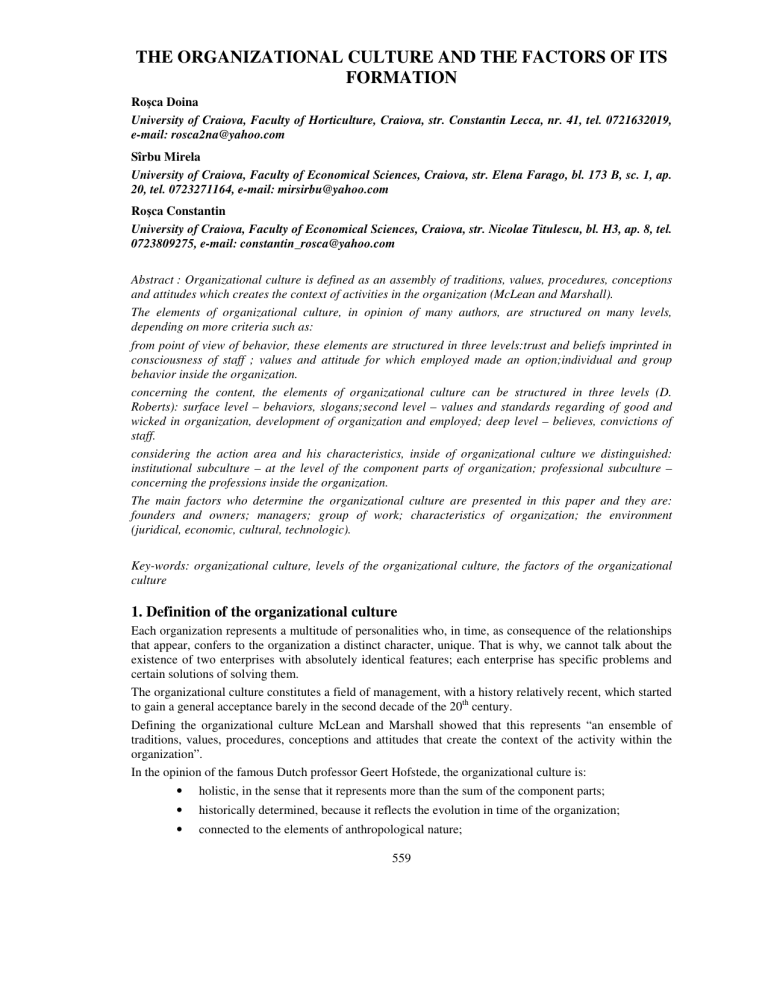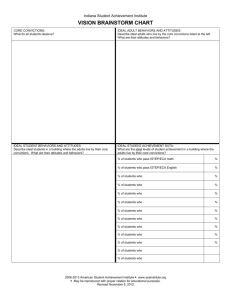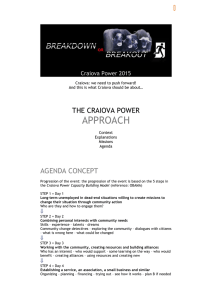THE ORGANIZATIONAL CULTURE AND THE FACTORS OF ITS

THE ORGANIZATIONAL CULTURE AND THE FACTORS OF ITS
FORMATION
Ro ca Doina
University of Craiova, Faculty of Horticulture, Craiova, str. Constantin Lecca, nr. 41, tel. 0721632019, e-mail: rosca2na@yahoo.com
Sîrbu Mirela
University of Craiova, Faculty of Economical Sciences, Craiova, str. Elena Farago, bl. 173 B, sc. 1, ap.
20, tel. 0723271164, e-mail: mirsirbu@yahoo.com
Ro ca Constantin
University of Craiova, Faculty of Economical Sciences, Craiova, str. Nicolae Titulescu, bl. H3, ap. 8, tel.
0723809275, e-mail: constantin_rosca@yahoo.com
Abstract : Organizational culture is defined as an assembly of traditions, values, procedures, conceptions and attitudes which creates the context of activities in the organization (McLean and Marshall).
The elements of organizational culture, in opinion of many authors, are structured on many levels, depending on more criteria such as: from point of view of behavior, these elements are structured in three levels:trust and beliefs imprinted in consciousness of staff ; values and attitude for which employed made an option;individual and group behavior inside the organization. concerning the content, the elements of organizational culture can be structured in three levels (D.
Roberts): surface level – behaviors, slogans;second level – values and standards regarding of good and wicked in organization, development of organization and employed; deep level – believes, convictions of staff. considering the action area and his characteristics, inside of organizational culture we distinguished: institutional subculture – at the level of the component parts of organization; professional subculture – concerning the professions inside the organization.
The main factors who determine the organizational culture are presented in this paper and they are: founders and owners; managers; group of work; characteristics of organization; the environment
(juridical, economic, cultural, technologic).
Key-words: organizational culture, levels of the organizational culture, the factors of the organizational culture
1. Definition of the organizational culture
Each organization represents a multitude of personalities who, in time, as consequence of the relationships that appear, confers to the organization a distinct character, unique. That is why, we cannot talk about the existence of two enterprises with absolutely identical features; each enterprise has specific problems and certain solutions of solving them.
The organizational culture constitutes a field of management, with a history relatively recent, which started to gain a general acceptance barely in the second decade of the 20 th
century.
Defining the organizational culture McLean and Marshall showed that this represents “an ensemble of traditions, values, procedures, conceptions and attitudes that create the context of the activity within the organization”.
In the opinion of the famous Dutch professor Geert Hofstede, the organizational culture is:
• holistic, in the sense that it represents more than the sum of the component parts;
• historically determined, because it reflects the evolution in time of the organization;
• connected to the elements of anthropological nature;
559
• socially founded, because it is created and kept by the group of persons who form the organization;
• difficult to change due to the complexes of the implied human elements.
The companies have ‘cultures’, as people have ‘personalities’. The culture of a company is its collection of beliefs and organic reactions almost instinctive, of heroes and negative characters, of realizations, interdictions and commandments. Some of these, as the neurosis of some people, are so deeply rooted, that their origin is lost in the darkness of the passed events, while others have living causes, visible.
The important aspect regarding the culture of a company is that people can familiarize better with the organization or even to anticipate the way of behavior, if they succeed to understand ‘the chemistry’ of its content. A commandment of the type ‘know yourself’ is pretty difficult for an individual. The company rarely knows what it needs to know about itself. To an individual, the way it is perceived his/her behavior can be shown by his/her best friend, the family’s doctor or by one of his/her colleagues from the study group. For a company, the observer who has the objectiveness and the interest to discover the mechanisms that lead to the functioning of the culture can be someone from the outside: an investor, a journalist, an analyst or a client.
The nature of the culture of an organization can be understood and viewed better if it is seen through the eyes of a foreign visitor. When someone sees the organization from a new angle, can perceive that intangible ‘social putty’ that holds everything together: the way in which the language, norms, values, rituals, myths, anecdotes and routine create that ‘coherent reality’ that molds the work of the people and the attitude they have towards it.
All the processes that take place within an enterprise, irrespective of their nature, are influenced by the organizational culture. Practically, in each organization there can be differentiated a formal and an informal organization, that cannot be separated. If the formal organization functions according the rules, politics and procedures, the informal organization develops spontaneously and can include individuals from different organizational levels. The informal organization implies relationships and human interactions within the organization, which are not officially prescribed, and has a dynamic character. It helps to the reduction of the tensions and is due to the needs of people of affiliation, friendship, security.
Within it, there can be distinguished the informal network of communication. Sometimes, this helps to the supplementation of the formal communication and often transmits the information more rapidly than through the official channels of communication. There are also disadvantages; thus, there can be transmitted erroneous information, suspicions, and half truths.
2. Levels of the organizational culture
Williams, Dobson and Walters structure the elements of the organizational culture on three levels:
• of beliefs and convictions, registered in the consciousness of the personnel of whom often is not aware of;
• of values and attitudes, which the employees of the organization choose and display;
• of the individual and group behavior within the organization, that can be perceived through spontaneous and systematic observations.
D. Roberts decelerates within the organizational culture other three levels:
• the exterior level, of surface – behaviors, slogans;
• the second level – values and norms partied by the employees of the organization regarding to what is good and bad, assuming the risks, the development of the organization and the employees;
• the tertiary level or profound level – beliefs, convictions of the employees.
Within the organizational culture of a company there can be differentiated, through the characteristics, more organizational sub-cultures:
• institutional sub-cultures – are shaped at the level of the main organizational sub-divisions of the company;
560
• professional sub-cultures – reflect the specific of the main categories of employees according to their profession.
3. The factors of formation of the organizational culture
The factors that influence the formation of the organizational culture, in general, and of the organizational culture of business, are numerous. From these we have stopped upon the most important.
The working group. The working groups appear in organizations in different forms. The working force is created by a formal authority, the organizations being networks of working groups. The variables that determine the formation of the group can be delimitated into the personal characteristics (personality, experience, training, attitudes), situational variables (the tasks to fulfill, available space, the way of granting the awards – respectively the group as a whole or the individual). Groups appear due to the need of affiliation, the necessity to reach the goals, physical approach, compatibility between the personalities, the attitudes and values of the individuals. The nature of the group and the number of members affect the perceptions regarding the nature of the organizational culture. Each employee brings into the organization convictions, attitudes, behaviors, from whose intertwining results the organizational culture.
The implication regarding the mission of the group influences the cultural perceptions. At the same time, the relationships within the group are decisive for the process of creation of the organization’s culture.
The general existent attitudes towards the risk and the existence of conflict, the types of relationships of communication will have a considerable impact upon the working group. They affect, at the same time, the amplitude of the innovation and organizational creativeness. According these factors, the members of the organization will develop an impression about ‘what kind of working place is that’.
The style of leadership of the managers. This has a considerable effect upon the culture of a group. If the manager is distant towards his/her subordinates, this attitude can have a negative impact upon the culture.
The trust in the manager, the embodiment of the chief in a positive example can influence favorably the efficacy of the group.
The managers always influence, substantially, the organizational culture, their influence being proportional to the hierarchical level. At the same hierarchical level, the influence differs from one manager to another, because the level of training and the leading style are not the same.
The organizational characteristics. They can affect, also, the type of culture that it is developed. The organizations differ according attributes as measure and complexity. Between the complexity of the organization’s culture and the size of the company (that can be expressed through the business figure, capital, number of employees) there is a direct proportional report. Moreover, the big organizations tend to higher degrees of specialization and towards a bigger impersonal character.
Usually, in the small companies the culture is more homogenous, while in the big companies are clearly shaped the sub-cultures. The organizations, also, differ according the degree of formalization (expressed in rules, politics, norms) and after the degree of decentralization and autonomy.
The history of the company represents a factor with profound influence upon the organizational culture with tradition; at the same time, it differentiates the cultures of these organizations from thecultures of the new enterprises. The stage of the life cycle of the company can constitute an important factor rarely taken into consideration.
The economic situation of the company influences the organizational culture by its restrictions and economic facilities.
The founders and owners. In many cases, the founders create the philosophy of the company and determine the basic values. The owners of the company can exert their influence from more points of view: of the type of owner (natural and/or juridical persons); the number of owners. When there are a reduced number of owners, their influence can be more profound
The environment (juridical, economic, cultural, technological). The juridical environment can influence the organizational culture positively or negatively. When it includes contradictory elements its influence upon the organizational culture is negative. The economic environment of the company reflects the status of the national economy. Thus, the economic crisis is also reflected at the organizational level. The individual who enter or are within an organization of businesses are ‘impregnated’ with the values, beliefs, attitudes that come from the national culture. The economic culture is derived from the national culture and
561
presents particularities for each country, which manifests upon other variables – owners, employees, managers. The technique and technology used refer to the degree of technical endowment and the type of technologies used, which have implications over the organizational culture. Thus, the amplification of the degree of technical endowment of the companies has implications over the content of the organizational culture, after the reduction of the frequency and intensity of human contacts.
4. Short conclusions.
The cultural elements that are defined by Edgar Schein as ‘solutions learned of the problems’ identify two types of learning situations, which in practice intertwine.
In case of positive solution of the problem, the group tries different answers until the problem is solved. On the contrary, in case of avoidance of anxiety, once an answer is learned because it avoids successfully the anxiety, it will probably be repeated by an undefined number of times. Thus, all the rituals, the models of thinking and the behaviors can be initially motivated by the need of avoiding a situation of anxiety.
The cultural elements based on the reduction of anxiety will be more stable than those based upon the positive solving of the problem, due to the nature of the mechanism of reduction of anxiety and the fact that the human systems require certain stability for avoiding anxiety.
The majority of the cultural solutions within the new organizations come from early founders or leaders of these. The founders have the biggest influence, but, while the group is consolidated, its members will find their own cultural solutions.
There is a certain ‘force’ of the culture, which can be defined according the: homogeneity and stability of the members of the group; the dimension and intensity of the experience shared by the group. If a group has a long and prosperous history, succeeding to defeat more difficult problems of survival, it will have a strong culture.
If the group is characterized by a fragile stability, by its members who were together for short time and did not confront with no difficult problem, the group will have a weak culture, even if the individuals within the group may have very strong individual presumptions. There must be sufficient experiences shared by the group, in order to have defined a culture. From this point of view, the companies with tradition can be considered as having strong cultures, while the very young companies can be considered as having weak cultures. There can be stated that the individual is subject to a process of socialization to which it is subjected any member of the society.
The organizational socialization is the process through which the new members learn the basic goals of the organization, the preferred means by which can be reached the goals, the responsibilities, the models of behavior, the rules and the principles that allow the maintenance of the identity and integrity of the enterprise.
The socialization can be collective and individual, formal (attributions in this respect revert to the managers and the departments of human resources) or informal. Irrespective of its type, we remark two features:
• it is continuous;
• often, the members are not conscious of its existence.
Because the culture serves to the function of stability of the external and internal environment of an organization, there must be ‘handed in’ to the new members, who must perceive it as correct. We cannot forget the following aspect: some new members bring new ideas and can thus contribute to the changing of the culture, especially if the ideas are brought to the highest levels of the organization.
Bibliography
1.
Hofstede Geert, The management of multicultural structures, Publishing House Economic ,
Bucharest, 1996.
2.
Ionescu Gh. Gheorghe, The cultural dimensions of management , Publishing House Economic ,
Bucharest, 1996.
562










